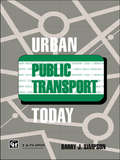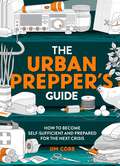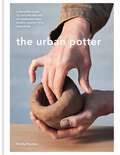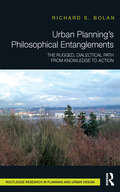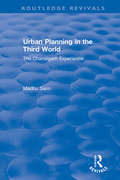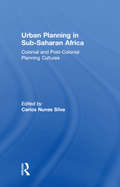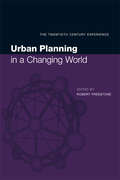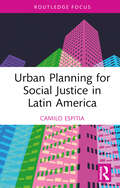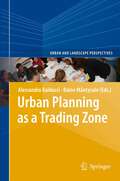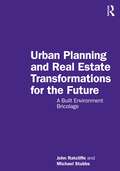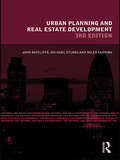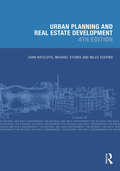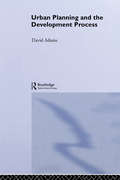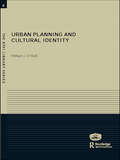- Table View
- List View
The Urban Section: An analytical tool for cities and streets
by Robert ManthoThe design of streets, and the connections between streets of different character, is the most important task for architects and urbanists working in an urban context. Considered at two distinct spatial scales – that of the individual street – the Street Section – and the complex of city streets – the City Transect – Urban Section identifies a range of generic street types and their success or otherwise in responding to climatic, cultural, traditional, morphological, social and economic well being. Using comparative studies a profile of best practice in street and city design is identified, showing methodologies in both the analysis of, and design for, successful streets and public places – place-making. In uniquely dealing with both the historic and contemporary description and analysis of urban ‘streets’ around the world, the work is of both academic and professional interest to architects, urban planners and designers, highway engineers, landscape and urban design advisers in both the public and private sectors; students, amenity and civic societies, city authorities and government agencies.
Urban Public Transport Today
by Dr Barry Simpson B. SimpsonThis book is about how local public transport can be made a less unacceptable alternative to the private car than it is now. It is intended for officials, politicians and others interested in the land use/local transport conundrum. It is also valuable to town planners, those working for passenger transport authorities and anyone concerned with policy making and project appraisal for local public transport.
Urban Public Transport Today
by Dr Barry Simpson B. SimpsonThis book is about how local public transport can be made a less unacceptable alternative to the private car than it is now. It is intended for officials, politicians and others interested in the land use/local transport conundrum. It is also valuable to town planners, those working for passenger transport authorities and anyone concerned with policy making and project appraisal for local public transport.
The Urban Prepper's Guide: How To Become Self-Sufficient And Prepared For The Next Crisis
by Jim CobbPrepare for future worst-case scenarios while learning to be self-sufficient every day. It's become clear that even in the twenty-first century our comfortable lives can be disrupted at a moment's notice by events far beyond our control. Whether these are global disasters like a pandemic or a continent-spanning war, or local catastrophes like wildfires, floods, power outages or even food-and-essentials supply issues, you need to know how to respond to a wide variety of emergencies.Written by Jim Cobb, an authority on prepping and disaster readiness, The Urban Prepper's Guide will introduce you to techniques and strategies that can prepare your home and loved ones. These simple measures – designed specifically for urban and suburban dwellers who have tight budgets and limited space – include: • Water – how to safely store and purify water • Food – how to store, preserve, and cook food in an emergency • Shelter – how to shield yourself from the elements without power • Medical – how to be prepared for injuries and illnesses • Security – how to protect your house and valuables • Communication – how to stay informed in an emergency • Every Day Carry – how to be ready to handle problems wherever you are • Home Safety – how to protect against fire and other accidents • Financial Preparedness – how to start planning on a tight budget • Soft Skills – how to think clearly and communicate effectively in a crisis • Emergency Evacuation – how to be ready to evacuate at a moment's notice • Mindset – how to develop a survivor's mindset, and all that entails • The First 24 Hours – how to handle everything when the worst happens
The Urban Potter: A modern guide to the ancient art of hand-building bowls, plates, pots and more
by Emily ProctorDiscover the slow, tactile art of hand-building ceramics and express yourself through the act of creating unique, timeless pieces for your home.The Urban Potter teaches you how to make beautiful, one-off handcrafted pieces with simple, natural shapes and neutral tones. Ceramicist Emily Proctor's unique, self-taught style embraces irregularity and asymmetry - here, there is no such thing as perfection, every piece is created through an authentic, intuitive process, with no wheel required.The 24 step-by-step projects include functional homeware such as bowls, plates and vases, as well as other decorative accessories, and are ordered by difficulty, making this book suitable for anyone who wants to play with clay, from beginners through to more seasoned ceramicists. For each project, Emily guides you through the whole process and explains all the techniques involved, from slabbing and pinching, to carving and glazing, while also fully leaning into the joys of slow ceramics and the mindful, patient nature of the art.
Urban Planning’s Philosophical Entanglements: The Rugged, Dialectical Path from Knowledge to Action
by Richard S BolanUrban Planning’s Philosophical Entanglements explores the long-held idea that urban planning is the link in moving from knowledge to action. Observing that the knowledge domain of the planning profession is constantly expanding, the approach is a deep philosophical analysis of what is the quality and character of understanding that urban planners need for expert engagement in urban planning episodes. This book philosophically analyses the problems in understanding the nature of action — both individual and social action. Included in the analysis are the philosophical concerns regarding space/place and the institution of private property. The final chapter extensively explores the linkage between knowledge and action. This emerges as the process of design in seeking better urban communities — design processes that go beyond buildings, tools, or fashions but are focused on bettering human urban relationships. Urban Planning’s Philosophical Entanglements provides rich analysis and understanding of the theory and history of planning and what it means for planning practitioners on the ground.
Urban Planning’s Philosophical Entanglements: The Rugged, Dialectical Path from Knowledge to Action
by Richard S BolanUrban Planning’s Philosophical Entanglements explores the long-held idea that urban planning is the link in moving from knowledge to action. Observing that the knowledge domain of the planning profession is constantly expanding, the approach is a deep philosophical analysis of what is the quality and character of understanding that urban planners need for expert engagement in urban planning episodes. This book philosophically analyses the problems in understanding the nature of action — both individual and social action. Included in the analysis are the philosophical concerns regarding space/place and the institution of private property. The final chapter extensively explores the linkage between knowledge and action. This emerges as the process of design in seeking better urban communities — design processes that go beyond buildings, tools, or fashions but are focused on bettering human urban relationships. Urban Planning’s Philosophical Entanglements provides rich analysis and understanding of the theory and history of planning and what it means for planning practitioners on the ground.
Urban Planning in the Third World: The Chandigarh Experience (Routledge Revivals)
by Madhu SarinOriginally published in 1982 Urban Planning in the Third World is concerned with some of the critical issues underlying urban planning in the Third World. Taking the specific case of Chandigarh, planned or rather ‘designed’ by Le Corbusier as the new capital of Punjab following Partition, the author describes the development of the city, showing how concepts inherent in the master plan and the policies pursued in its implementation not merely ignored, but totally excluded a major section of the population from ‘legal’ housing and employment. The book sets a distinct theoretical framework, examining the Indian context at the time of Independence, the Western origins of the planning concepts applied in the city, and the process by which Le Corbusier finalized its master plan in a matter of days. The book also examines the social forces determining the temporary resolution of inherent conflicts in the plan and examines the growth of non-plan settlements in the city and the impact of the plan on the lives of the settlement residents.
Urban Planning in the Third World: The Chandigarh Experience (Routledge Revivals)
by Madhu SarinOriginally published in 1982 Urban Planning in the Third World is concerned with some of the critical issues underlying urban planning in the Third World. Taking the specific case of Chandigarh, planned or rather ‘designed’ by Le Corbusier as the new capital of Punjab following Partition, the author describes the development of the city, showing how concepts inherent in the master plan and the policies pursued in its implementation not merely ignored, but totally excluded a major section of the population from ‘legal’ housing and employment. The book sets a distinct theoretical framework, examining the Indian context at the time of Independence, the Western origins of the planning concepts applied in the city, and the process by which Le Corbusier finalized its master plan in a matter of days. The book also examines the social forces determining the temporary resolution of inherent conflicts in the plan and examines the growth of non-plan settlements in the city and the impact of the plan on the lives of the settlement residents.
Urban Planning in Sub-Saharan Africa: Colonial and Post-Colonial Planning Cultures
by Carlos Nunes SilvaCities in Sub-Saharan Africa are unequally confronted with social, economic and environmental challenges, particularly those related with population growth, urban sprawl, and informality. This complex and uneven African urban condition requires an open discussion of past and current urban planning practices and future reforms. Urban Planning in Sub-Saharan Africa gives a broad perspective of the history of urban planning in Sub-Saharan Africa and a critical view of issues, problems, challenges and opportunities confronting urban policy makers. The book examines the rich variety of planning cultures in Africa, offers a unique view on the introduction and development of urban planning in Sub-Saharan Africa, and makes a significant contribution against the tendency to over-generalize Africa’s urban problems and Africa’s urban planning practices. Urban Planning in Sub-Saharan Africa is written for postgraduate students and advanced undergraduates, researchers, planners and other policy makers in the multidisciplinary field of Urban Planning, in particular for those working in Spatial Planning, Architecture, Geography, and History.
Urban Planning in Sub-Saharan Africa: Colonial and Post-Colonial Planning Cultures
by Carlos Nunes SilvaCities in Sub-Saharan Africa are unequally confronted with social, economic and environmental challenges, particularly those related with population growth, urban sprawl, and informality. This complex and uneven African urban condition requires an open discussion of past and current urban planning practices and future reforms. Urban Planning in Sub-Saharan Africa gives a broad perspective of the history of urban planning in Sub-Saharan Africa and a critical view of issues, problems, challenges and opportunities confronting urban policy makers. The book examines the rich variety of planning cultures in Africa, offers a unique view on the introduction and development of urban planning in Sub-Saharan Africa, and makes a significant contribution against the tendency to over-generalize Africa’s urban problems and Africa’s urban planning practices. Urban Planning in Sub-Saharan Africa is written for postgraduate students and advanced undergraduates, researchers, planners and other policy makers in the multidisciplinary field of Urban Planning, in particular for those working in Spatial Planning, Architecture, Geography, and History.
Urban Planning in a Changing World: The Twentieth Century Experience
by FreestoneUrban planning in today's world is inextricably linked to the processes of mass urbanization and modernization which have transformed our lives over the last hundred years. Written by leading experts and commentators from around the world, this collection of original essays will form an unprecedented critical survey of the state of urban planning a
Urban Planning in a Changing World: The Twentieth Century Experience (Studies In History, Planning, And The Environment)
by FreestoneUrban planning in today's world is inextricably linked to the processes of mass urbanization and modernization which have transformed our lives over the last hundred years. Written by leading experts and commentators from around the world, this collection of original essays will form an unprecedented critical survey of the state of urban planning a
Urban Planning for Social Justice in Latin America
by Camilo EspitiaUrban Planning for Social Justice in Latin America explores how urban planning can be used as a tool for social equity. The book examines several Latin American cities, each with specific challenges, and explores how they have gradually overcome these difficulties through policies, planning, and design, and with private/public sector coordination. The cases include: The built environment and social mobility in Bogotá; Mexico City and its difficulties with water scarcity; Addressing air quality and environmental justice in Lima; Santiago de Chile’s energy consumption and carbon footprint; Buenos Aires and the issue of urban agriculture and food security; Connectivity as a social transformation device in Medellín. The book goes beyond simply identifying the challenges and explains some of the practical day-to-day planning efforts, including interviews with staff from those municipalities, illustrations, and strategies that have been successful. As a result, this book will be helpful to planners in the region, as well as outside Latin America, because it demonstrates how fruitful results can be achieved in areas typically perceived as underdeveloped. Although based on research and data, this book offers a positive perspective on the possibilities rather than the limitations, hoping to inspire new generations of planners to pursue careers in search of social change.
Urban Planning for Social Justice in Latin America
by Camilo EspitiaUrban Planning for Social Justice in Latin America explores how urban planning can be used as a tool for social equity. The book examines several Latin American cities, each with specific challenges, and explores how they have gradually overcome these difficulties through policies, planning, and design, and with private/public sector coordination. The cases include: The built environment and social mobility in Bogotá; Mexico City and its difficulties with water scarcity; Addressing air quality and environmental justice in Lima; Santiago de Chile’s energy consumption and carbon footprint; Buenos Aires and the issue of urban agriculture and food security; Connectivity as a social transformation device in Medellín. The book goes beyond simply identifying the challenges and explains some of the practical day-to-day planning efforts, including interviews with staff from those municipalities, illustrations, and strategies that have been successful. As a result, this book will be helpful to planners in the region, as well as outside Latin America, because it demonstrates how fruitful results can be achieved in areas typically perceived as underdeveloped. Although based on research and data, this book offers a positive perspective on the possibilities rather than the limitations, hoping to inspire new generations of planners to pursue careers in search of social change.
Urban Planning as a Trading Zone (Urban and Landscape Perspectives #13)
by Alessandro Balducci and Raine Mäntysalo'Trading zone' is a concept introduced by Peter Galison in his social scientific research on how scientists representing different sub-cultures and paradigms have been able to coordinate their interaction locally. In this book, Italian and Finnish planning researchers extend the use of the concept to different contexts of urban planning and management, where there is a need for new ideas and tools in managing the interaction of different stakeholders. The trading zone concept is approached as a tool in organizing local platforms and support systems for planning participation, knowledge production, decision making and local conflict management. In relation to the former theses of communicative planning theory that stress the ideals of consensus, mutual understanding and universal reason, the 'trading zone approach', outlined in this book, offers a different perspective. It focuses on the potentiality to coordinate locally the interaction of different stakeholders without requiring the deeper sharing of understandings, values and motives between them. Galison’s commentary comes in the form of the book’s final chapter.
Urban Planning and Real Estate Transformations for the Future: A Built Environment Bricolage
by John Ratcliffe Michael StubbsThis book presents fresh ways of thinking about the future for all those involved in conceiving, planning, designing, funding, constructing, occupying and managing the built environment, to face the challenges, and grasp the opportunities, that lie ahead over the next few decades. Four major themes form the basis of the volume:(1) Future Awareness and a New Sense of Place.(2) Global Governance and Anticipatory Leadership. (3) Innovation, Reform and Exemplars. (4) Urban Planning and Real Estate Transformations. Within these structural themes are a diverse range of 'Discourses' addressing many of the big questions and driving forces that face us, together with a proposed methodology (Strategic Foresight) and an array of practical illustrations viewing what can be done today – whether by organisations, individuals, cities or communities – to positively shape a preferred future and manipulate us towards achieving it. It will be important reading for students, practitioners, agencies and corporations across the built environment, especially in the fields of urban planning, real estate development, architecture, civil engineering and construction.
Urban Planning and Real Estate Transformations for the Future: A Built Environment Bricolage
by John Ratcliffe Michael StubbsThis book presents fresh ways of thinking about the future for all those involved in conceiving, planning, designing, funding, constructing, occupying and managing the built environment, to face the challenges, and grasp the opportunities, that lie ahead over the next few decades. Four major themes form the basis of the volume:(1) Future Awareness and a New Sense of Place.(2) Global Governance and Anticipatory Leadership. (3) Innovation, Reform and Exemplars. (4) Urban Planning and Real Estate Transformations. Within these structural themes are a diverse range of 'Discourses' addressing many of the big questions and driving forces that face us, together with a proposed methodology (Strategic Foresight) and an array of practical illustrations viewing what can be done today – whether by organisations, individuals, cities or communities – to positively shape a preferred future and manipulate us towards achieving it. It will be important reading for students, practitioners, agencies and corporations across the built environment, especially in the fields of urban planning, real estate development, architecture, civil engineering and construction.
Urban Planning and Real Estate Development (Natural and Built Environment Series)
by John Ratcliffe Michael Stubbs Miles KeepingThe twin processes of planning and property development are inextricably linked – it’s not possible to carry out a development strategy without an understanding of the planning process, and equally planners need to know how real estate developers do their job. This third edition of Urban Planning and Real Estate Development guides students through the procedural and practical aspects of developing land from the point of view of both planner and developer. The planning system is explained, from the increasing emphasis on spatial planning at a regional level down to the detailed perspective of the development control process and the specialist requirements of historic buildings and conservation areas. At the same time the authors explain the entire development process from inception through appraisal, valuation and financing to completion and disposal. This is an invaluable textbook for real estate and planning students, and helps to meet the requirements of the RICS and RTPI Assessment of Professional Competence.
Urban Planning and Real Estate Development (Natural and Built Environment Series)
by John Ratcliffe Michael Stubbs Miles KeepingThis fourth edition of Urban Planning and Real Estate Development guides readers through the procedural and practical aspects of developing land from the point of view of both planner and developer. The twin processes of planning and property development are inextricably linked – it is not possible to carry out a development strategy without an understanding of the planning process, and, equally, planners need to know how real estate developers do their job. The planning system is explained, from the increasing emphasis on spatial planning at a national, local, and neighbourhood level down to the detailed perspective of the development management process and the specialist requirements of historic buildings and conservation areas. At the same time, the authors explain the entire development process from inception, through appraisal, valuation, and financing, to completion. Sustainability and corporate social responsibility and their impact on planning and development are covered in detail, and the future consequences of the COVID-19 pandemic are explored in new opening and closing chapters setting the text in a global context. Written by a team of authors with many years of academic, professional, and research experience, and illustrated throughout with practical case studies and follow-up resources, this book is an invaluable textbook for real estate and planning students and helps to meet the requirements of the RICS and RTPI Assessment of Professional Competence.
Urban Planning and Real Estate Development (Natural and Built Environment Series)
by John Ratcliffe Michael Stubbs Miles KeepingThis fourth edition of Urban Planning and Real Estate Development guides readers through the procedural and practical aspects of developing land from the point of view of both planner and developer. The twin processes of planning and property development are inextricably linked – it is not possible to carry out a development strategy without an understanding of the planning process, and, equally, planners need to know how real estate developers do their job. The planning system is explained, from the increasing emphasis on spatial planning at a national, local, and neighbourhood level down to the detailed perspective of the development management process and the specialist requirements of historic buildings and conservation areas. At the same time, the authors explain the entire development process from inception, through appraisal, valuation, and financing, to completion. Sustainability and corporate social responsibility and their impact on planning and development are covered in detail, and the future consequences of the COVID-19 pandemic are explored in new opening and closing chapters setting the text in a global context. Written by a team of authors with many years of academic, professional, and research experience, and illustrated throughout with practical case studies and follow-up resources, this book is an invaluable textbook for real estate and planning students and helps to meet the requirements of the RICS and RTPI Assessment of Professional Competence.
Urban Planning And The Development Process
by David AdamsThis text is about the very essence of urban planning in a market economy. It is concerned with people - landowners, developers, investors, politicians and ordinary members of the public - who produce change in towns and cities as they relate to each other and react to development Pressure. Whether Such Change Occurs Slowly And Is Almost Unnoticed, Or happens rapidly and is highly disruptive, a production process is creating a finished product: the built environment. This form of production, known as the land and property development process, is regulated but not controlled by the state. Urban planning is therefore best considered as one form of state intervention in the development process.; Since urban planning would have no legitimate basis without state power, it is an inherently political activity, able to alter the distribution of scarce environmental resources. Through doing so, it seeks to resolve conflicts of interest over the use and development of land. However, urban plans that appear to favour particular interests such as house-builders above others such as community groups provoke intense controversy. Development planning can thus become highly politicized, with alliances and divisions between politicians not always explained by traditional party politics.; These issues are explored with particular reference to statutory plan-making at the local level. The author draws on his extensive research into urban planning and development, making use of recent case studies and examples to illustrate key points. There are four parts. The first explores the operation of land and property markets and development processes, and examines how the state intervenes in the form of urban planning. The second part looks at the people and organizations who play a critical role in shaping the built environment and considers their relationship with the planning system. Specific attention is paid to important actors in the development process, such as landowners, developers, financial institutions, professional advisers and to the variety of agencies in the public sector that aim to promote development. This concludes with discussion of public- private partnerships and growth coalitions. The third part of the book concentrates on local development planning.
Urban Planning And The Development Process
by David AdamsThis text is about the very essence of urban planning in a market economy. It is concerned with people - landowners, developers, investors, politicians and ordinary members of the public - who produce change in towns and cities as they relate to each other and react to development Pressure. Whether Such Change Occurs Slowly And Is Almost Unnoticed, Or happens rapidly and is highly disruptive, a production process is creating a finished product: the built environment. This form of production, known as the land and property development process, is regulated but not controlled by the state. Urban planning is therefore best considered as one form of state intervention in the development process.; Since urban planning would have no legitimate basis without state power, it is an inherently political activity, able to alter the distribution of scarce environmental resources. Through doing so, it seeks to resolve conflicts of interest over the use and development of land. However, urban plans that appear to favour particular interests such as house-builders above others such as community groups provoke intense controversy. Development planning can thus become highly politicized, with alliances and divisions between politicians not always explained by traditional party politics.; These issues are explored with particular reference to statutory plan-making at the local level. The author draws on his extensive research into urban planning and development, making use of recent case studies and examples to illustrate key points. There are four parts. The first explores the operation of land and property markets and development processes, and examines how the state intervenes in the form of urban planning. The second part looks at the people and organizations who play a critical role in shaping the built environment and considers their relationship with the planning system. Specific attention is paid to important actors in the development process, such as landowners, developers, financial institutions, professional advisers and to the variety of agencies in the public sector that aim to promote development. This concludes with discussion of public- private partnerships and growth coalitions. The third part of the book concentrates on local development planning.
Urban Planning and Cultural Identity (RTPI Library Series)
by William NeillUrban Planning and Cultural Identity reviews the intense spatiality of conflict over identity construction in three cities where culture and place identity are not just post-modernist playthings but touch on the raw sensibilities of who people define themselves to be. Berlin as the reborn German capital has put 'coming to terms with' the Holocaust and the memory of the GDR full square at the centre of urban planning. Detroit raises questions about the impotence and complicity of planners in the face of the most extreme metropolitan spatial apartheid in the United States and where African-American identity now seems set on a separatist course. In Belfast, in the clash of Irish nationalist and Ulster unionist traditions, place can take on intense emotional meanings in relation to which planners as 'mediators of space' can seem ill equipped.The book, drawing on extensive interview sources in the case study cities, poses a question of broad relevance. Can planners fashion a role in using environmental concerns such as Local Agenda 21 as a vehicle of building a sense of common citizenship in which cultural difference can embed itself?
Urban Planning and Cultural Identity (RTPI Library Series)
by William NeillUrban Planning and Cultural Identity reviews the intense spatiality of conflict over identity construction in three cities where culture and place identity are not just post-modernist playthings but touch on the raw sensibilities of who people define themselves to be. Berlin as the reborn German capital has put 'coming to terms with' the Holocaust and the memory of the GDR full square at the centre of urban planning. Detroit raises questions about the impotence and complicity of planners in the face of the most extreme metropolitan spatial apartheid in the United States and where African-American identity now seems set on a separatist course. In Belfast, in the clash of Irish nationalist and Ulster unionist traditions, place can take on intense emotional meanings in relation to which planners as 'mediators of space' can seem ill equipped.The book, drawing on extensive interview sources in the case study cities, poses a question of broad relevance. Can planners fashion a role in using environmental concerns such as Local Agenda 21 as a vehicle of building a sense of common citizenship in which cultural difference can embed itself?

